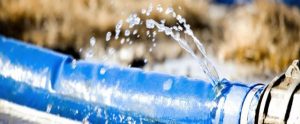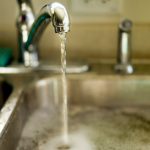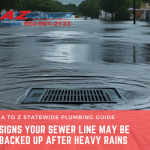Detecting leaks is not as hard as you may think. The best way to determine if you have a leak in your plumbing system, is by first checking your water meter. If you do not know where your meter is located you can call you local water billing department to get your meter location. Below are some tips on how to detect leaks.
- Make sure water is not being used inside or outside of your house.
- Locate your water meter and check the leak indicator to see if it is moving. Depending on the brand of your meter, the leak indicator could be a small triangular shaped dial or a small silver wheel that rotates when water is flowing through the meter. If the dial is moving, then you have a leak somewhere.
- Or, you can also take a meter reading and wait 1 or 2 hours and take another meter reading (make sure no water is used during this time). If the reading has changed, then you have a leak.
 After you have determined that you have a leak, the next step is to determine if the leak is inside or outside of your house.
After you have determined that you have a leak, the next step is to determine if the leak is inside or outside of your house.
- Locate your home’s main shut off valve and shut off the water at the valve. Typically, you will find the shut off valve in the basement or garage directly behind an outdoor faucet, or outside below an outdoor faucet.
- Again, check the leak indicator for movement or use the meter reading method, making sure not to use any water during this period. If the leak indicator stops moving or there is no change in the meter readings, then you have a leak inside of the house. If the leak indicator continues to move or there is a change in the meter readings, then the leak is outside between the meter and the house.
- If you are unable to locate the leak, you may need to call a plumber.
Leaking Faucets
 Leaking faucets are generally a result of a worn rubber washer. The washer on a sink is usually located under the handle. These are relatively easy to replace, if you have the right tools. It does require shutting off the water under the sink or at the main shutoff valve and removing the handle. (Note: faucet handles are not shutoff valves.)Check your local home center or hardware store on how to repair faucet leaks.
Leaking faucets are generally a result of a worn rubber washer. The washer on a sink is usually located under the handle. These are relatively easy to replace, if you have the right tools. It does require shutting off the water under the sink or at the main shutoff valve and removing the handle. (Note: faucet handles are not shutoff valves.)Check your local home center or hardware store on how to repair faucet leaks.
Leaking Toilets
Toilet leaks can waste hundreds of gallons and often times are silent. Even a small leak can add up to a lot of wasted water and money over time. Fortunately, most toilet leaks are easy and inexpensive to repair.
To help determine if you have a leaking toilet, simply remove the tank lid and place a few drops of food coloring in back of the toilet tank. (If you don’t have food coloring, you can purchase dye tabs from any hardware or home center).  Wait about 30 minutes, without flushing, and then look in the toilet bowl to see of any color has come through. If the water is clear, water is not leaking. If you see food coloring in the bowl you have a leak.
Wait about 30 minutes, without flushing, and then look in the toilet bowl to see of any color has come through. If the water is clear, water is not leaking. If you see food coloring in the bowl you have a leak.
In most cases, you will simply just need to replace the toilet flapper and/or filling mechanism. These are available at hardware or home center stores for about $8.00 each.
Flapper Valve Leaks
Another most common reason for a leaking toilet is one that has an improperly working or sealing flapper. The flapper is the rubber valve in the bottom of the tank that lifts up when the toilet is flushed. If the flapper is worn or cracked, it allows water to continuously flow from the tank into the toilet bowl without flushing.
Flush Handle Problems
If the handle needs to be jiggled to keep the toilet from running, the flush level bar and chain (or the handle itself) may be sticking. Adjust the nut that secures it in the toilet tank. If that does not work, the handle may have to be replaced.
Finding Other Water Leaks
The water you drink and bathe with is delivered under pressure, so a leak can be very obvious. Wastewater, on the other hand, is usually moved by gravity and is not under pressure. This makes wastewater leaks much harder to detect. If you suspect a wastewater leak, please call our Maintenance & Operations department for help.
Be aware that the exact location of a leak may not always be immediately obvious. Some leaks may start at one location, then flow along a ledge or other channel for a distance before they drain down and create some visible damage.
Look for wet, warped or discoloration stains on your ceilings, floors, walls and woodwork (such as the bottom of your kitchen or bathroom sink cabinet). As you attempt repair, be sure to check twice for the actual location of the leak, not just the resulting damage from the leak.
Condensation can also be a form of water leak. While condensation is normal, excessive condensation can cause damage to your walls, ceilings, floors and woodworking. If there is too much condensation, insulating your pipes may stop or reduce the condensation.






